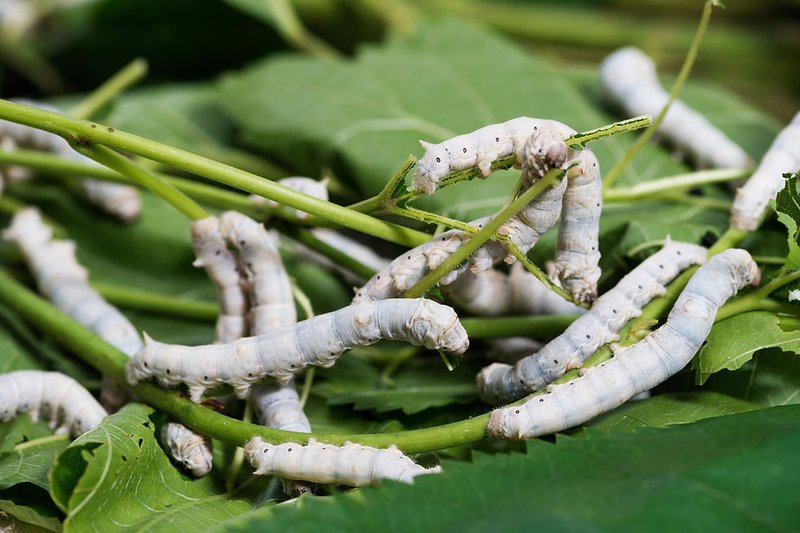
Silkworms are pretty remarkable. They go through four life stages: egg, larva, pupa, and adult moth. The best part? You can nurture them in small spaces, making this an ideal project for city folks! You might be wondering how this all works or what you need to start. Let’s dive into the ins and outs of silkworm cultivation and why it might just be the perfect addition to your urban lifestyle.
Why Consider Silkworm Cultivation?
You might be curious about the benefits of raising silkworms. For starters, they’re a fantastic way to learn about **entomology** (that’s just a fancy word for the study of insects). Plus, they’re surprisingly low maintenance. Silkworms feed primarily on mulberry leaves, which means you can grow them right alongside your other plants. This makes it an easy way to integrate nature into your urban life.
Not only is raising silkworms educational, but it can also be a fun hobby. Watching them grow from tiny eggs to silky caterpillars can be truly mesmerizing. And if you’re into crafts, you can turn the silk they produce into beautiful items, from scarves to decorative pieces. It’s like creating a piece of art right before your eyes—what’s not to love about that?
Choosing the Right Space
Now, let’s talk about where to set up your silkworm microfarm. You don’t need a huge area; a small corner of your balcony, a spare room, or even a dedicated shelf can work perfectly. The key is to ensure the space has good ventilation and is kept at a steady room temperature, ideally between 70°F to 80°F (21°C to 27°C).
Make sure your space is also **clean and free of pests**. Silkworms can be sensitive to unwanted insects or molds, so a tidy environment will help keep them healthy. You might want to use plastic bins with screens or mesh lids, which provide airflow while keeping the little critters safe.
Getting Started: What You Need
Before you get your silkworms, gather some essential supplies. Here’s a quick list to kickstart your journey:
- Silkworm eggs: You can find these from reputable suppliers online or locally.
- Mulberry leaves: Fresh is best! If you can’t find mulberry trees nearby, you can grow your own.
- Containers: Shallow bins or trays work well to house your worms.
- Humidity control: A small humidifier can help maintain the right moisture levels.
- Temperature monitor: Keeping track of the room temperature is crucial!
Once you’ve got everything set up, you’re ready to order your silkworm eggs. They come in different varieties, so do a little research to see which ones suit your needs best.
Life Cycle of Silkworms: What to Expect
Understanding the life cycle of silkworms is essential to successful cultivation. Here’s a brief overview:
1. **Egg Stage:** Silkworms start as tiny eggs, usually laid by adult moths. They can take about 10 days to hatch into larvae, depending on temperature.
2. **Larva Stage:** This is where the magic happens! Silkworms spend around 4 to 6 weeks eating and growing. They’ll molt multiple times, getting larger with each shed.
3. **Pupa Stage:** Once they reach maturity, they’ll stop eating and spin themselves into cocoons. This stage lasts about 10 days.
4. **Adult Moth:** Finally, the adult moth emerges, ready to mate and lay more eggs, starting the cycle over again.
Each stage presents its unique care requirements and fun facts. For example, did you know that silkworms can consume their weight in mulberry leaves daily? That’s a lot of munching and growing!
Caring for Your Silkworms
Caring for silkworms doesn’t have to be complicated. Here are some pointers to keep your little buddies happy and healthy:
– **Feeding:** Provide fresh mulberry leaves daily. You can chop them up into smaller pieces to make it easier for the worms to munch away.
– **Humidity and Temperature:** Keep an eye on humidity, ideally around 60-70%, and the temperature should remain stable. Too much humidity can lead to mold, while too little might stress the worms.
– **Cleaning:** Regularly clean their bins to prevent waste buildup, which can attract pests. Just be gentle when handling the worms, as they’re delicate creatures.
– **Observation:** Spend time watching them grow! This is not only enjoyable but also allows you to catch any potential problems early on.
Harvesting Silk: The Process
Once your silkworms have spun their cocoons, it’s time for the exciting part—harvesting silk! But hold on; you have a choice here. You can either let the moths emerge or use the cocoons to make silk.
If you decide to harvest, here’s a quick rundown:
1. Gently collect the cocoons after they’ve dried for a day or two.
2. Boil water and submerge the cocoons to loosen the silk fibers.
3. Carefully unroll the silk to reveal long strands—this can be a meticulous process but well worth it!
Keep in mind that while harvesting means you won’t get to see the adult moths, it allows you to create beautiful silk products.
Common Challenges in Silkworm Cultivation
Like any hobby, you may run into some challenges with silkworm cultivation. Here are a few common issues and how to handle them:
– **Mold Growth:** If you notice mold forming in your silkworm’s habitat, check for overfeeding or poor ventilation. Making sure your bins are clean and your environment is controlled will help prevent this.
– **Pest Infestation:** Keep an eye out for pests like ants or flies. If you spot them, clean the area immediately and ensure your food supply is fresh and properly stored.
– **Not Eating:** If your silkworms stop eating, it could be due to changes in temperature or humidity. Make adjustments and ensure they’re comfortable.
Every urban microfarm will have its own quirks, but with a little patience and care, you’ll be amazed at how resilient these little creatures can be.
Final Thoughts: The Joy of Urban Farming
Silkworm cultivation in urban microfarms might be one of the most rewarding experiences you can have right in your home. You’re not just raising worms; you’re engaging with nature and learning about life cycles, sustainability, and responsibility. So, grab those eggs, set up your space, and get started on this unique adventure.
You might even find that it helps you connect with your community or spark conversations. Plus, who wouldn’t love to share a story about the time they raised silkworms in their apartment? So go ahead, embrace the trend and see where this journey takes you!

